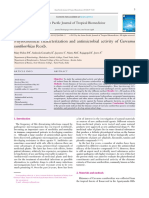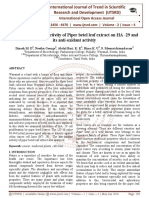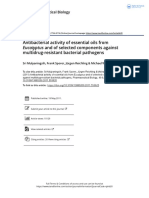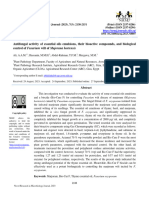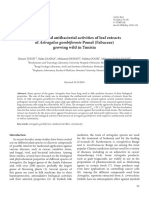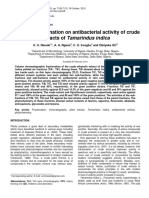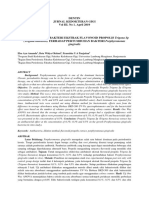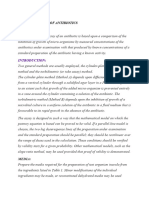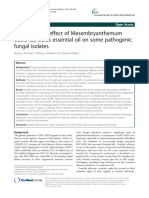Antimicrobial Effect of Plant Oils Against Some Bacterias Izolated From Patients Samples
Antimicrobial Effect of Plant Oils Against Some Bacterias Izolated From Patients Samples
Uploaded by
brislet RCopyright:
Available Formats
Antimicrobial Effect of Plant Oils Against Some Bacterias Izolated From Patients Samples
Antimicrobial Effect of Plant Oils Against Some Bacterias Izolated From Patients Samples
Uploaded by
brislet ROriginal Title
Copyright
Available Formats
Share this document
Did you find this document useful?
Is this content inappropriate?
Copyright:
Available Formats
Antimicrobial Effect of Plant Oils Against Some Bacterias Izolated From Patients Samples
Antimicrobial Effect of Plant Oils Against Some Bacterias Izolated From Patients Samples
Uploaded by
brislet RCopyright:
Available Formats
See discussions, stats, and author profiles for this publication at: https://www.researchgate.
net/publication/325645006
Antimicrobial Effect of Plant Oils against Some Bacterias Izolated from
Patients Samples
Article in Journal of molecular and genetic medicine: an international journal of biomedical research · June 2018
DOI: 10.4172/1747-0862.1000318
CITATION READS
1 104
3 authors, including:
Saban Kordali Ayse Usanmaz Bozhüyük
Mugla Üniversitesi Igdir Üniversitesi
78 PUBLICATIONS 3,181 CITATIONS 25 PUBLICATIONS 43 CITATIONS
SEE PROFILE SEE PROFILE
Some of the authors of this publication are also working on these related projects:
Effects of Olea europaea L. Leaf Metabolites on the Tilapia (Oreochromis niloticus) and Three Stored Pests, Sitophilus granarius, Tribolium confusum and
Acanthoscelides obtectus View project
All content following this page was uploaded by Ayse Usanmaz Bozhüyük on 08 June 2018.
The user has requested enhancement of the downloaded file.
ular and Ge
Journal of Molecular and Genetic
ec
Balkan et al., J Mol Genet Med 2018, 12:1
l
ne
urnal of Mo
tic M icine
DOI: 10.4172/1747-0862.1000318
ed
Medicine
Jo
ISSN: 1747-0862
Research Article
Research Article Open Access
Open Access
Antimicrobial Effect of Plant Oils against Some Bacterias Izolated from
Patients Samples
Balkan CE1, Kordali S2 and Bozhüyük AU3
Faculty of Medical Science, Department of Medical Microbiology, Kafkas University, Turkey
1
Faculty of Agriculture, Department of Plant Protection, Ataturk University, Turkey
2
Faculty of Agriculture, Department of Plant Protection, Iğdır University, Turkey
3
Abstract
Aim: The aim of present study was to compare the antibacterial potential of Thymus sipyleus boiss. subsp.
sipyleus boiss. var. sipyleus L. (Thymol and camphor both tested), Satureja thymbra L. and Origanum onites L. by
Kirby Bauer disc diffusion method.
Methods: We isolated Enterococcus spp., E. coli, Morgonella morganii, Pseudomonas aeruginosa, MSSA,
Klebsiella pneumonia and Proteus mirabilis from different patient samples. The antibacterial activity of each oils
was evaluated by the Kirby Bauer disc diffusion method.
Results: Proteus mirabilis were the most susceptible bacteria against essential oils, followed by Klebsiella
pneumonia and Morganella morganii. Pseudomonas aeruginosa did not show susceptibility to any oil.
Conclusion: The essential oils of the T. sipyleus, O. onites and S. thymbra were especially very effective
against the resistant strains such as Enterococcus spp. and Klebsiella pneumonia. In this group the maximum
antimicrobial activity was observed with the essential oils of Origanum onites and Satureja thymbra. We think that
these oils can be proposed in treatment process as an alternative application structures in the future.
Keywords: Antimicrobial; Disc diffusion; Essential oils of Agriculture, the Department of Plant Protection, Erzurum, Turkey.
Aerial parts of the plants were dried in shade and ground in a grinder.
Introduction The dried plant samples (500 g) were subjected to hydro distillation
This study was undertaken to determine the in vitro antimicrobial for 4 h using a Clevenger-type apparatus. The oil yields of O. onites, S.
activities of three commercial essential oils and their main components thymbra and T. sipyleus were 4.5%, 2.3%, 1.17% and 0.98% (w/w, dry
in order to pre-select candidates for potential infections. The weight basis), respectively. The yield was based on dry materials of plant
antibacterial effects against pathogenic bacteria which are isolated samples. The oils were dried over a hydrous Na2SO4 and stored under
from patient’s samples (Enterococcus spp., E. coli, Morgonella morganii, N2 in a sealed vial until required, and then stored at 4°C until used for
Pseudomonas aeruginosa, MSSA, Klebsiella pneumonia and Proteus toxicity bioassays. The pure compounds were purchased commercially
mirabilis) were tested using paper disk diffusion method. These from Fluka and Sigma. [Camphor (Fluka, purity 97%), Thymol (Sigma,
materials could be served as an important natural alternative to prevent purity 95%)]. The compounds tested for toxicity against Enterococcus
bacterial infections in the future (Table 1). spp., E. coli, Morgonella morganii, Pseudomonas aeruginosa, MSSA,
Klebsiella pneumonia and Proteus mirabilis.
One of the most popular spices used around the world is Origanum
onites L. It is used also as a medicinal therapy, arousing interest not Collection of bacteria
only in the use of its leaves in folk medicine, but also in relation to its
Enterococcus spp., E. coli, Morgonella morganii, Pseudomonas
essential oil for therapeutic purposes and treatment [1].
aeruginosa, MSSA, Klebsiella pneumonia and Proteus mirabilis isolated
Species of the genus Satureja (family Lamiaceae) are widely from different patient samples in the laboratory of clinical microbiology
distributed in the Mediterranean area, Asia, regularly found in warm, with VITEC microbial identification system.
dry, rocky habitats also in east part of Turkey [2]. Satureja consists
of about 200 species, usually aromatic herbs and used for treatment. Kirby-Bauer disc diffusion method
S. thymbra oil has been found to have a good antimicrobial activity The experiment was performed with a bacterial inoculum of 0.5
against various bacteria [3-5]. McFarland; Mueller-Hinton (MH) was inoculated with each bacterial
The genus Thymus, member of the Lamiaceae family, contains about
400 species of perennial aromatic, evergreen or semi-evergreen various
plants with many subspecies, varieties, sub-varieties and forms are mostly *Corresponding author: Dr. Çiğdem Eda Balkan, Faculty of Medical Science,
Department of Medical Microbiology, Kafkas University, Turkey, Tel: 90 474 225 11
distributed in the Mediterranean area and also in Turkey [6]. 67; E-mail: cigdemedabalkan@gmail.com
Materials and Methods Received December 28, 2017; Accepted January 12, 2018; Published January 16,
2018
Plant material and isolation of essential oil Citation: Balkan CE, Kordali S, Bozhüyük AU (2018) Antimicrobial Effect of Plant
Oils against Some Bacterias Izolated from Patients Samples. J Mol Genet Med 12:
Origanum onites L. (Lamiaceae), L. (Labiatae), Satureja thymbra
318 doi:10.4172/1747-0862.1000318
L. (Labiatae), Thymus sipyleus boiss. subsp. sipyleus boiss. var. sipyleus
L. (Lamiaceae) were collected at the flowering stage from different Copyright: © 2018 Balkan CE, et al. This is an open-access article distributed
under the terms of the Creative Commons Attribution License, which permits
regions of Turkey between June and August. Voucher specimens unrestricted use, distribution, and reproduction in any medium, provided the
have been deposited in the herbarium of Ataturk University, Faculty original author and source are credited
J Mol Genet Med, an open access journal
ISSN: 1747-0862 Volume 12 • Issue 1 • 1000318
Citation: Balkan CE, Kordali S, Bozhüyük AU (2018) Antimicrobial Effect of Plant Oils against Some Bacterias Izolated from Patients Samples. J Mol
Genet Med 12: 318 doi:10.4172/1747-0862.1000318
Page 2 of 2
pathogen or non-pathogen bacteria cannot be attributed to one specific
mechanism [12].
Enterococcus spp., E. coli, Morgonella morganii, Pseudomonas
aeruginosa, MSSA, Klebsiella pneumonia and Proteus mirabilis are
the most important causes of some infections, and the emergence of
resistance to antibiotics is a serious public health problem.
Conclusion
In our hands, comparison of their results of this study with
previously published data is difficult because the composition of
plant oil products is known to vary according to local air conditions,
Figure 1: Muller-Hinton agar base with each bacteria and oils in a sterile filter
paper disc. After 24 hours period inhibition zones were measured.
soil composition and to extraction techniques. Moreover, the results
obtained may differ because of the method used to assess antimicrobial
activity and quantity of oil.
Entero- Morgan- Pseudomo- Klebsiella
Thymus E. Proteus
coccus ella mor- nas aerugi- MSSA pneumo- The essential oils of the T. sipyleus, O. onites and S. thymbra were
sypleus coli mirabilis
Spp. ganii nosa nia
especially very effective against the resistant strains such as Enterococcus
Kirby- 14 13
Bauer
17 mm
mm
20 mm 0 mm
mm
22 mm 23 mm spp. and Klebsiella pneumonia. The maximum antimicrobial activity
Satura- Entero- Morgan- Pseudomo- Klebsiella was observed with the essential oils of Origanum onites and Satureja
E. Proteus thymbra.
ja thym- coccus ella mor- nas aerugi- MSSA pneumo-
coli mirabilis
bra Spp ganii nosa nia
References
Kirby- 18 14
21 mm 30 mm 0 mm 18 mm 30 mm
Bauer mm mm 1. Sarac N, Ugur A (2008) Antimicrobial activities of the essential oils of Origanum
Origa- Entero- Morgan- Pseudomo- Klebsiella onites L, Origanum vulgare L. subspecies hirtum (Link) Ietswaart, Satureja
E. Proteus
num coccus ella mor- nas aerugi- MSSA pneumo- thymbra L, and Thymus cilicicus Boiss and Bal growing wild in Turkey. J Med
coli mirabilis
onites Spp ganii nosa nia Food 11: 568-573.
Kirby- 18
18 mm 16 mm 0 mm 9 mm 13 mm 18 mm 2. Giweli A, Džamić AM, Soković M, Ristić MS, Marin PD (2012) Antimicrobial
Bauer mm
and antioxidant activities of essential oils of Satureja thymbra growing wild in
Entero- Morgan- Pseudomo- Klebsiella Libya. Molecules 17: 4836-4850.
Cam- E. Proteus
coccus ella mor- nas aerugi- MSSA pneumo-
phor coli mirabilis
Spp ganii nosa nia 3. Gören AC, Topçu G, Bilsel G, Bilsel M, Wilkinson JM, et al. (2004) Analysis
Kirby- 0 of essential oil of Satureja thymbra by hydrodistillation, thermal desorber,
0 mm 0 mm 0 mm 0 mm 12 mm 0 mm
Bauer mm and headspace GC/MS techniques and its antimicrobial activity. Nat Product
*Mean values in Kirby-Bauer disc diffusion method expressed as mm Res18: 189-195.
Table 1: The results of the antibacterial assays in terms of Kirby Bauer (Inhibition 4. Sarac N, Ugur A (2008) Antimicrobial activities of the essential oils of Origanum
ranged from 0 mm to 30 mm). onites L, Origanum vulgare L. subspecies hirtum (Link) Ietswaart, Satureja
thymbra L and Thymus cilicicus Boiss and Bal growing wild in Turkey. J Med
strain. Each oil was applied to a sterile filter paper disc (6-mm diameter) Food 11: 568-573.
2 µl placed on the surface of inoculated plates; duplicate plates for each 5. Azaz AD, Kürkcüoglu M, Satil F, Baser CKH, Tümen G (2005) In vitro
oil were used. After overnight incubation at 37°C, the inhibition zones antimicrobial activity and chemical composition of some Satureja essential
were measured. Control plates were prepared by placing sterile water oils. J Flav Frag 20: 587-591.
for negative controls (Figure 1 and Table 1). 6. De Martino L, Bruno M, Formisano C, De Feo V, Napolitano F, et al. (2009)
Chemical composition and antimicrobial activity of the essential oils from two
Results species of Thymus growing wild in southern Italy. Molecules 14: 4614-4624.
Proteus mirabilis were the most susceptible, followed by Klebsiella 7. Sienkiewicz M, Lysakowska M, Ciecwierz J, Denys P, Kowalczyk E (2011)
pneumonia and Morganella morganii, Pseudomonas aeruginosa did not Antibacterial activity of thyme and lavender essential oils. Med Chem 7: 674-
689.
show susceptibility to any oil. Klebsiella pneumonia susceptible, other
oils did not show susceptibility to the camphor oil. 8. Rota MC, Herrera A, Martínez RM, Sotomayor JA, Jordán MJ (2008)
Antimicrobial activity and chemical composition of Thymus vulgaris, Thymus
Discussion zygis and Thymus hyemalis essential oils. Food Control 19: 681-687.
In the literature, the results of experiments showed that the oil from 9. Abu-Shanab B, Adwan GM, Abu-Safiya D, Jarrar N, Adwan K (2005)
Antibacterial activities of some plant extracts utilized in popular medicine in
Thymus exhibited extremely strong activity against all of the clinical Palestine. Turkish J Biol 28: 99-102.
strains. In traditional popular medicine, Thymus spp. essential oil has
been traditionally used to treat respiratory tract disorders and wound 10. Dorman HJD, Deans SG (2000) Antimicrobial agents from plants: Antibacterial
activity of plant volatile oils. J Appl Microbiol 88: 308-316.
infections; using of Thymus derivatives has been used to treat wound
infections, cough, and sputum treatment. Over the past few years, 11. Skandamis P, Koutsoumanis K, Nychas GJE, Fasseas K (2001) Inhibition
the interest in natural medicine has been increasing in industrialized of oregano essential oil and EDTA on Escherichia coli O157: H7 [Food
hygiene]. Italian J Food Sci.
societies and in medical area also. It is evident that there is a relationship
between the high activity of thymol oil and the presence of phenol 12. Carson CF, Mee BJ, Riley TV (2002) Mechanism of action of Melaleuca
components such as thymol and carvacrol to the bacterias [7-11]. alternifolia (tea tree) oil on Staphylococcus aureus determined by time-kill,
lysis, leakage, and salt tolerance assays and electron microscopy. Antimicrob
According to literatures, the mode of action of essential oils against Agents Chemoth 46: 1914-1920.
J Mol Genet Med, an open access journal
ISSN: 1747-0862 Volume 12 • Issue 1 • 1000318
View publication stats
You might also like
- Aromatherapy For ParrotsDocument69 pagesAromatherapy For ParrotsCamila Carvalho De SouzaNo ratings yet
- Why I Left Orthodox Medicine PDF - by Derrick Lonsdale (Vitamin B1 - Thiamine) - Why I Left Orthodox MedicineDocument198 pagesWhy I Left Orthodox Medicine PDF - by Derrick Lonsdale (Vitamin B1 - Thiamine) - Why I Left Orthodox MedicineEbook Pdf100% (1)
- Chemical Composition of 8 Eucalyptus SpeDocument15 pagesChemical Composition of 8 Eucalyptus SpeAlex osorioNo ratings yet
- Study of The Antibacterial Activity of Essential Oils of Three Moroccan and Aromatics Plants On Four Bacterial StrainsDocument9 pagesStudy of The Antibacterial Activity of Essential Oils of Three Moroccan and Aromatics Plants On Four Bacterial StrainsOpenaccess Research paperNo ratings yet
- HelenDocument4 pagesHelenAhmad BukhariNo ratings yet
- mbl-48-2-148Document10 pagesmbl-48-2-148Handan BaysalNo ratings yet
- Antimicrobial Activity of Seeds and Leaves of Myristica Fragrans Against Multi-Resistant MicroorganismsDocument8 pagesAntimicrobial Activity of Seeds and Leaves of Myristica Fragrans Against Multi-Resistant MicroorganismsulyaNo ratings yet
- Fu 2007Document6 pagesFu 2007RékaNo ratings yet
- Phytochemical Screening and in Vitro Antimicrobial Activity of Typha Angustifolia Linn Leaves Extract Against Pathogenic Gram Negative Micro OrganismsDocument4 pagesPhytochemical Screening and in Vitro Antimicrobial Activity of Typha Angustifolia Linn Leaves Extract Against Pathogenic Gram Negative Micro Organismsumeshbt720No ratings yet
- Fontanesii Boiss. Et Reut. and Origanum Glandulosum Desf. Essential OilsDocument8 pagesFontanesii Boiss. Et Reut. and Origanum Glandulosum Desf. Essential OilsBAZNAS Kabupaten MajalengkaNo ratings yet
- In Vitro Investigation of The Antibacterial Activity of Nigella Sativa Oil On Some of The Most Commonly Isolated Bacteria in Otitis Media and ExternaDocument5 pagesIn Vitro Investigation of The Antibacterial Activity of Nigella Sativa Oil On Some of The Most Commonly Isolated Bacteria in Otitis Media and ExternaAnggie DiniayuningrumNo ratings yet
- Bioactivity of Artemisia Herba Alba Essential Oil Against Plant Pathogenic FungiDocument7 pagesBioactivity of Artemisia Herba Alba Essential Oil Against Plant Pathogenic Fungisunaina agarwalNo ratings yet
- 165 - 170 in Vitro ScreeningDocument7 pages165 - 170 in Vitro ScreeningabirNo ratings yet
- Provided For Non-Commercial Research and Education Use. Not For Reproduction, Distribution or Commercial UseDocument13 pagesProvided For Non-Commercial Research and Education Use. Not For Reproduction, Distribution or Commercial UseSilvana NurulfauziyyahNo ratings yet
- Sulaiman Ali Al YousefDocument12 pagesSulaiman Ali Al YousefRifqi UlilNo ratings yet
- Comparitive Study On The Antioxidant, Anticancer and Antimicrobial Property of (J. E. Lange) Imbach Before and After BoilingDocument8 pagesComparitive Study On The Antioxidant, Anticancer and Antimicrobial Property of (J. E. Lange) Imbach Before and After BoilingAKNo ratings yet
- Evaluation of Antimicrobial Activity of Moringa Oleifera Leaf Extracts Against Pathogenic Bacteria Isolated From Urinary Tract Infected PatientsDocument5 pagesEvaluation of Antimicrobial Activity of Moringa Oleifera Leaf Extracts Against Pathogenic Bacteria Isolated From Urinary Tract Infected PatientsKanhiya MahourNo ratings yet
- Antifeedant and Antimicrobial Activity Of: Tylophora IndicaDocument5 pagesAntifeedant and Antimicrobial Activity Of: Tylophora IndicaRahul RanaNo ratings yet
- CHEMICAL COMPOSITION AND ANTIMICROBIAL PROPERTIES OF ALGERIAN CEDRUS ATLANTICADocument8 pagesCHEMICAL COMPOSITION AND ANTIMICROBIAL PROPERTIES OF ALGERIAN CEDRUS ATLANTICAReasmey TANNo ratings yet
- D292C7167116Document12 pagesD292C7167116Yuliana SuryaNo ratings yet
- Lavicidal and Pupicidal Activities of Petroselinum Crispum Seed Essential Oil On Culex Pipiens and Culiseta Longiareolata MosquitoesDocument11 pagesLavicidal and Pupicidal Activities of Petroselinum Crispum Seed Essential Oil On Culex Pipiens and Culiseta Longiareolata MosquitoesPanagiotis EliopoulosNo ratings yet
- PR 13110Document8 pagesPR 13110RyanNo ratings yet
- El Ouadi 2017Document31 pagesEl Ouadi 2017khadijaNo ratings yet
- Chemical Composition and Larvicidal Acti PDFDocument5 pagesChemical Composition and Larvicidal Acti PDFJeannie Marzan MerinNo ratings yet
- Antimicrobial Activity of Clementine Peel Essential Oil With ItsDocument5 pagesAntimicrobial Activity of Clementine Peel Essential Oil With Itsfauziahhusna16No ratings yet
- In Vitro Anti-Cancer Activity of Piper Betel Leaf Extract On HA - 29 and Its Anti-Oxidant ActivityDocument4 pagesIn Vitro Anti-Cancer Activity of Piper Betel Leaf Extract On HA - 29 and Its Anti-Oxidant ActivityEditor IJTSRDNo ratings yet
- Klebsiella, Salmonella Staphylococcus Aureus: Growth Inhibitory Effect of Ethanolic Neem Leaves Extract On andDocument4 pagesKlebsiella, Salmonella Staphylococcus Aureus: Growth Inhibitory Effect of Ethanolic Neem Leaves Extract On androcioNo ratings yet
- Kordali 2008Document9 pagesKordali 2008khadijaNo ratings yet
- Telekia SpeciosaDocument6 pagesTelekia SpeciosaZoran MaksimovićNo ratings yet
- 4476 PDFDocument5 pages4476 PDFRicardo A. Forero R.No ratings yet
- In Vitro Evaluation of Antifungal Effects of Lawsonia Inermis, Pistacia Lentiscus and Juglans RegiaDocument7 pagesIn Vitro Evaluation of Antifungal Effects of Lawsonia Inermis, Pistacia Lentiscus and Juglans RegiaTuấn Nguyen AnhNo ratings yet
- Ebadollahi 2017Document6 pagesEbadollahi 2017Abdenour AdjaoudNo ratings yet
- Antimicrobial Activity in Leaf Extract of Neem in BroilerDocument7 pagesAntimicrobial Activity in Leaf Extract of Neem in Broilerjerubandivamshi23No ratings yet
- Antibacterial Activity and in Vitro Callus Induction of Hybanthus Enneaspermus (L.) F. MuellDocument10 pagesAntibacterial Activity and in Vitro Callus Induction of Hybanthus Enneaspermus (L.) F. MuellTJPRC PublicationsNo ratings yet
- Isolation Partial Purification and Evaluation of BDocument12 pagesIsolation Partial Purification and Evaluation of BMahesh KumarNo ratings yet
- Potential Antibacterial Potential of Moringa Olifera against Multidrug Resistant Wound Infecting BacteriaDocument4 pagesPotential Antibacterial Potential of Moringa Olifera against Multidrug Resistant Wound Infecting BacteriaInternational Journal of Innovative Science and Research TechnologyNo ratings yet
- 10.28955-alinterizbd.445016-674440Document4 pages10.28955-alinterizbd.445016-674440abilashsundaresan04No ratings yet
- Bouguerraetal.19 TRDocument10 pagesBouguerraetal.19 TRRolando RomeroNo ratings yet
- Antibacterial Activities of The Leaf and Bark Extract of Persea AmericanaDocument8 pagesAntibacterial Activities of The Leaf and Bark Extract of Persea AmericanafebbyNo ratings yet
- Antimicrobial Activity of Essential Oil Extract of Ocimum Basilicum L. Leaves On A Variety of PathogDocument4 pagesAntimicrobial Activity of Essential Oil Extract of Ocimum Basilicum L. Leaves On A Variety of PathogAna TorresNo ratings yet
- Daferera Et Al. 2003 PhytopathogensDocument7 pagesDaferera Et Al. 2003 PhytopathogensManuel PerezNo ratings yet
- EAJBSF - Volume 11 - Issue 1 - Pages 51-64Document15 pagesEAJBSF - Volume 11 - Issue 1 - Pages 51-64MAambiental ambientalNo ratings yet
- 1 s2.0 S1878818119312046 MainDocument5 pages1 s2.0 S1878818119312046 MainKhoirun NisyakNo ratings yet
- 1-s2.0-S2214785322061375-mainDocument7 pages1-s2.0-S2214785322061375-mainYassin AlamiNo ratings yet
- Antibacterial and Antifungal Activity of CorchorusDocument4 pagesAntibacterial and Antifungal Activity of CorchorusazxilNo ratings yet
- Stevia Antibcterial Study PDFDocument5 pagesStevia Antibcterial Study PDFOmar PortoNo ratings yet
- Characterization of Local Trichoderma Spp. As Potential Bio-Control Agents, Screening of in Vitro Antagonistic Activities and Fungicide Tolerance (#467155) - 547952Document15 pagesCharacterization of Local Trichoderma Spp. As Potential Bio-Control Agents, Screening of in Vitro Antagonistic Activities and Fungicide Tolerance (#467155) - 547952dawit gNo ratings yet
- A Comparative Study of Effect of EssentiDocument5 pagesA Comparative Study of Effect of Essentidebby elizafitriNo ratings yet
- Penting AromadendeDocument8 pagesPenting AromadendeAizhuuaf TurquoiseNo ratings yet
- 1354796956-Haruna+et+al 312012EJMP2220Document13 pages1354796956-Haruna+et+al 312012EJMP2220Lina WinartiNo ratings yet
- Phytochemical Analysis and Study of Antioxidant, AnticandidalDocument10 pagesPhytochemical Analysis and Study of Antioxidant, Anticandidalabdelmajid khabbachNo ratings yet
- Neethu Article PDFDocument5 pagesNeethu Article PDFSarathchandran Chandrashekar ShenoyNo ratings yet
- Antifungal Activity of Essential Oils Emulsions, Their Bioactive Compounds, and Biological Control of Fusarium Wilt of Majorana HortensisDocument14 pagesAntifungal Activity of Essential Oils Emulsions, Their Bioactive Compounds, and Biological Control of Fusarium Wilt of Majorana Hortensisabdallah aliNo ratings yet
- Biy 36 1 7 1010 131Document6 pagesBiy 36 1 7 1010 131Cesar MartinezNo ratings yet
- Antimicrobial Effect of The Lingzhi or Reishi Medicinal Mushroom, Ganoderma Lucidum (Higher Basidiomycetes) and Its Main CompoundsDocument9 pagesAntimicrobial Effect of The Lingzhi or Reishi Medicinal Mushroom, Ganoderma Lucidum (Higher Basidiomycetes) and Its Main CompoundsbryanNo ratings yet
- 739-ArticleText-928-1-10-20210208Document6 pages739-ArticleText-928-1-10-20210208Alexis Martínez GómezNo ratings yet
- Ajol File Journals - 82 - Articles - 130308 - Submission - Proof - 130308 973 352379 1 10 20160210Document6 pagesAjol File Journals - 82 - Articles - 130308 - Submission - Proof - 130308 973 352379 1 10 20160210Sean Kerby PalimaNo ratings yet
- 1 SMDocument4 pages1 SMAbraham YirguNo ratings yet
- ShowPDF PaperDocument7 pagesShowPDF PaperLeandro DouglasNo ratings yet
- Rosemary AntibacterialDocument5 pagesRosemary AntibacterialNurul Izzah Wahidul AzamNo ratings yet
- Comparison of Antimicrobial Activities of Clove Oil & Its Extract On Some Food Borne MicrobesDocument7 pagesComparison of Antimicrobial Activities of Clove Oil & Its Extract On Some Food Borne MicrobesSeema YadavNo ratings yet
- Plant Disease Management Strategies for Sustainable Agriculture through Traditional and Modern ApproachesFrom EverandPlant Disease Management Strategies for Sustainable Agriculture through Traditional and Modern ApproachesImran Ul HaqNo ratings yet
- Coursebook Answers Chapter 10 Asal BiologyDocument8 pagesCoursebook Answers Chapter 10 Asal BiologyKlaus GerhardtNo ratings yet
- 12 Lactic Acid Bacteria SerumDocument4 pages12 Lactic Acid Bacteria SerumCute Guardian AngelNo ratings yet
- Efficacy Test of A Hydrolysable Tannin Extract Against Necrotic Enteritis in Challenged Broiler ChickensDocument5 pagesEfficacy Test of A Hydrolysable Tannin Extract Against Necrotic Enteritis in Challenged Broiler ChickensgorrikNo ratings yet
- Application of Nanomaterials in Medicine: Drug Delivery, Diagnostics and TherapeuticsDocument27 pagesApplication of Nanomaterials in Medicine: Drug Delivery, Diagnostics and TherapeuticsPremier PublishersNo ratings yet
- Immediate Download Cosmetic Microbiology A Practical Approach 2nd Edition Geis Phil Ebooks 2024Document84 pagesImmediate Download Cosmetic Microbiology A Practical Approach 2nd Edition Geis Phil Ebooks 2024fekkaprunk100% (20)
- A Guide To The Treatment of Lower Respiratory Tract InfectionsDocument11 pagesA Guide To The Treatment of Lower Respiratory Tract InfectionsNurafiat AntonNo ratings yet
- 2015 - The Special Features of Alpha-Monolaurin To Support Poultry PerformanceDocument1 page2015 - The Special Features of Alpha-Monolaurin To Support Poultry PerformanceJuan DiegoNo ratings yet
- Burns Treatment Tea Tree OilDocument3 pagesBurns Treatment Tea Tree Oilam10No ratings yet
- Hugo and Russell's Pharmaceutical Microbiology 9th edition Edition Brendan F. Gilmore all chapter instant downloadDocument66 pagesHugo and Russell's Pharmaceutical Microbiology 9th edition Edition Brendan F. Gilmore all chapter instant downloadanderwannida100% (5)
- MARINE Drug PHARMACOGNOSYDocument24 pagesMARINE Drug PHARMACOGNOSYSweet 2No ratings yet
- Chemistry in Everyday Life One Shot BouncebackDocument136 pagesChemistry in Everyday Life One Shot BouncebackPratik RanjanNo ratings yet
- Curs Engleza 2014 PDFDocument263 pagesCurs Engleza 2014 PDFDeea TrancăNo ratings yet
- Local Drug Delivery in Periodontics: June 2023Document162 pagesLocal Drug Delivery in Periodontics: June 2023hammingtongraceNo ratings yet
- Thi thử KYS lần 8 - Môn Tiếng AnhDocument8 pagesThi thử KYS lần 8 - Môn Tiếng AnhNhư TâmNo ratings yet
- Iraqi Ministry of Health Medical City Baghdad Teaching Hospital Training Center of Clinical PharmacyDocument40 pagesIraqi Ministry of Health Medical City Baghdad Teaching Hospital Training Center of Clinical PharmacyLolo GhostNo ratings yet
- 987556Document104 pages987556konrajNo ratings yet
- 887 1551 2 PBDocument7 pages887 1551 2 PBAliyah SajaNo ratings yet
- лекция 8 Phlegmon of the floor of the mouth. Topographic anatomy of the floor of the mouth, sources of infection, possible ways of spreading the infection. Clinic, differential diagnostics. Surgery. PDocument41 pagesлекция 8 Phlegmon of the floor of the mouth. Topographic anatomy of the floor of the mouth, sources of infection, possible ways of spreading the infection. Clinic, differential diagnostics. Surgery. Ptalalelsherif92No ratings yet
- Effect of Aloe Vera On ChickensDocument11 pagesEffect of Aloe Vera On ChickensPathias MatamboNo ratings yet
- The Skin Microbiome: A New Actor in Inflammatory AcneDocument7 pagesThe Skin Microbiome: A New Actor in Inflammatory AcneTeguh PutraNo ratings yet
- Micro Lab 11Document3 pagesMicro Lab 11goatsecksNo ratings yet
- Fiebre de Origen Desconocido en Perros 2016Document6 pagesFiebre de Origen Desconocido en Perros 2016LABORATORIO ARBOLEDASNo ratings yet
- EXERCISE 9 - Antimicrobial Susceptibility Test LABORATORY ACTIVITY SHEEDocument3 pagesEXERCISE 9 - Antimicrobial Susceptibility Test LABORATORY ACTIVITY SHEEPOMPEYO BARROGANo ratings yet
- Global Action Plan EngDocument28 pagesGlobal Action Plan EngBoni MagtibayNo ratings yet
- Adult Bacterial Conjunctivitis: Resistance Patterns Over 12 Years in Patients Attending A Large Primary Eye Care Centre in The UKDocument4 pagesAdult Bacterial Conjunctivitis: Resistance Patterns Over 12 Years in Patients Attending A Large Primary Eye Care Centre in The UKegyzellahsNo ratings yet
- JWC 2022 InglesDocument21 pagesJWC 2022 InglesCynthia Andrade100% (1)
- Microbial Assay of AntibioticsDocument3 pagesMicrobial Assay of Antibioticsmuru geshNo ratings yet
- The Inhibitory Effect of Mesembryanthemum Edule Bolus Essential Oil On Some Pathogenic Fungal IsolatesDocument7 pagesThe Inhibitory Effect of Mesembryanthemum Edule Bolus Essential Oil On Some Pathogenic Fungal IsolatesDaniel MarţuneacNo ratings yet




